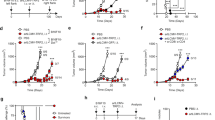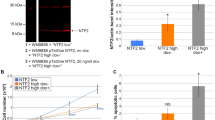Abstract
Unlike normal melanocytes, primary and metastatic human melanomas express high levels of basic fibroblast growth factor (bFGF) and fibroblast growth factor receptor-1 (FGFR-1) messenger RNA, and expression of these genes is essential in sustaining the proliferation of malignant melanomas in vitro. To determine whether bFGF and FGFR-1 are also required for tumor formation in these cells, liposome-mediated gene transfer was used to deliver episomal vectors containing antisense-oriented bFGF or FGFR-1 cDNAs into human melanomas, grown as subcutaneous tumors in nude mice. The growth of tumors injected with these constructs was completely arrested or the tumors regressed as a result of blocked intratumoral angiogenesis and subsequent necrosis. Thus, inhibition of bFGF/FGFR-1-mediated signaling may open a new avenue for the treatment of advanced-stage melanomas.
This is a preview of subscription content, access via your institution
Access options
Subscribe to this journal
Receive 12 print issues and online access
$209.00 per year
only $17.42 per issue
Buy this article
- Purchase on Springer Link
- Instant access to full article PDF
Prices may be subject to local taxes which are calculated during checkout
Similar content being viewed by others
References
Marincola, P.M. & Rosenberg, S.A. Biologic therapy with interleukin-2: Preclinical studies. in: Biologic Therapy of Cancer. (eds. DeVita, V.T., Jr., Hellman, S. & Rosenberg, S.A.) 250–262 (Lippincott, Philadelphia, 1995).
Kirkwood, J.M. Biologic therapy with interferon-α and β: Clinical applications. in: Biologic Therapy of Cancer. (eds. DeVita, V.T., Jr., Hellman, S. & Rosenberg, S.A.) 388–411 (Lippincott, Philadelphia, 1995).
Houghton, A.N. & Chapman, P.B. Clinical applications of monoclonal antibodies in cancer. in: Biologic Therapy of Cancer. (eds. DeVita, V.T., Jr., Hellman, S. & Rosenberg, S.A.) 576–590 (Lippincott, Philadelphia, 1995).
Van Der Bruggen, P. et al. A gene encoding an antigen recognized by cytolytic T lymphocytes on a human melanoma. Science 254, 1643–1647 (1991).
Halaban, R., Kwon, B.S., Ghosh, S., Delli-Bovi, P. & Baird, A. bFGF as an autocrine growth factor for human melanomas. Oncogene Res. 3, 177–186 (1988).
Becker, D., Meier, C.B. & Herlyn, M. Proliferation of human malignant melanomas is inhibited by antisense oligodeoxynucleotides targeted against basic fibroblast growth factor. EMBO J. 8, 3685–3691 (1989).
Becker, D., Lee, P.L., Rodeck, U. & Herlyn, M. Inhibition of the fibroblast growth factor receptor 1 (FGFR-1) gene in human melanocytes and malignant melanomas leads to inhibition of proliferation and signs indicative of differentiation. Oncogene 7, 2302–2313 (1992).
Abraham, J.A. et al. Human basic fibroblast growth factor: Nucleotide sequence and genomic organization. EMBO J. 5, 2523–2528 (1986).
Johnson, D.E., Lee, P.L., Lu, J. & Williams, L.T. Diverse forms of a receptor for acidic and basic fibroblast growth factors. Mol. Cell. Biol. 10, 4728–4739 (1990).
Johnson, D.E., Lu, J., Chen, S., Werner, S. & Williams, L.T. The human fibroblast growth factor genes: A common structural arrangement underlies the mechanism for generating receptors that differ in their third immunoglobulin domain. Mol. Cell. Biol. 11, 4627–4634 (1991).
Vignovich, J. & Becker, D. Expression of bFGF and differential expression of FGF receptors in normal human myoblasts and rhabdomyosarcomas. Int. J. Oncol. 2, 637–642 (1993).
Gao, X. & Huang, L. A novel cationic liposome reagent for efficient transfection of mammalian cells. Biochem. Biophys. Res. Commun. 179, 280–285 (1991).
Yang, J.-P. & Huang, L. Direct gene transfer to mouse melanoma by intratumor injection of free DMA. Gene Ther. 3, 542–547 (1996).
Nabel, G.J. et al. Direct gene transfer with DNA-liposome complexes in melanoma: Expression, biologic activity, and lack of toxicity in humans. Proc. Natl. Acad. Sci. USA 90, 11307–11311 (1993).
Werner, S. et al. Targeted expression of a dominant-negative FGF receptor mutant in the epidermis of transgenic mice reveals a role of FGF in keratinocyte organization and differentiation. EMBO J. 12, 2635–2643 (1993).
Nickoloff, R.J. PECAM-1 (CD31) is expressed on proliferating endothelial cells, stromal spindle-shaped cells, and dermal dendrocytes in Kaposi's sarcoma. J. Clin. Pathol. 43, 752–757 (1993).
Sehested, M. & Hou-Jensen, K. Factor VIII-related antigen as an endothelial cell marker in benign and malignant diseases. Virchows Arch. 391, 217–225 (1981).
Ledbetter, J.A. & Herzenberg, L.A. Xenogenic monoclonal antibodies to mouse lymphoid differentiation antigens. Immunol. Rev. 47, 63–67 (1979).
Herlyn, M., Mancianti, M.L., Jambrosic, J., Bolen, J.B. & Koprowski, H. Regulatory factors that determine growth and phenotype of normal human melanocytes. Exp. Cell Res. 179, 322–331 (1988).
Rodeck, U. et al. Constitutive expression of multiple growth factor genes by melanoma cells but not normal melanocytes. J. Invest. Dermatol. 97, 20–26 (1991).
Dionne, C.A. et al. Cloning and expression of two distinct high affinity receptors cross-reacting with acidic and basic fibroblast growth factors. EMBO J. 9, 2685–2692 (1990).
Keegan, K., Johnson, D.E., Williams, L.T. & Hayman, M.J. Isolation of an additional member of the fibroblast growth factor receptor family, FGFR-3. Proc. Natl. Acad. Sci. USA 88, 1095–1099 (1991).
Partanen, J. et al. FGFR-4, a novel acidic fibroblast growth factor receptor with a distinct expression pattern. EMBO J. 10, 1347–1354 (1991).
Ferrara, N., Houck, K.A., Jakeman, L.B., Winer, J. & Leung, D.W. The vascular endothelial growth factor family of polypeptides. J. Cell. Biochem. 47, 211–218 (1991).
Folkman, J. Tumor angiogenesis. in: The Molecular Basis of Cancer. (eds. Mendelsohn, J., Howley, P.M., M., Israel, M.A. & Liotta, LA.) 206–232 (Saunders, Philadelphia, 1995).
Hanahan, D. & Folkman, J. Patterns and emerging mechanisms of the angiogenic switch during tumorigenesis. Cell 86, 353–364 (1996).
Wang, Y. et al. Molecular analysis of melanoma precursor lesions. Cell Growth Differ. 7, 1733–1740 (1996).
Elder, D.E., Clark, W.H., Jr., Glenitsas, R., Guerry, D., IV & Halpern, A.C. The early and intermediate precursor lesions of tumor progression in the melanocytic system: Common acquired nevi and atypical (dysplastic) nevi. Semin. Diagn. Pathol. 10, 18–35 (1993).
Parangi, S. et al. Antiangiogenic therapy of transgenic mice impairs de novo tumor growth. Proc. Natl. Acad. Sci. USA 93, 2002–2007 (1996).
Singh, R.K. et al. Interferons alpha and beta down-regulate the expression of basic fibroblast growth factor in human carcinomas. Proc. Natl. Acad. Sci. USA 92, 4562–4566 (1995).
Brooks, P.C., Clark, R.A.F. & Cheresh, D.A. Requirement of vascular integrin αυβ3 for angiogenesis. Science 264, 569–57 (1994).
Brooks, P.C. et al. Integrin αυβ3 antagonists promote tumor regression by inducing apoptosis of angiogenic blood vessels. Cell 79, 1157–1164 (1994).
Montgomery, A.M.P., Reisfeld, R.A. & Cheresh, D.A. Integrin αυβ3 rescues melanoma cells from apoptosis in a three-dimensional dermal collagen. Proc. Natl. Acad. Sci. USA 91, 8856–8860 (1994).
Herlyn, M. et al. Biology of tumor progression in human melanocytes. Lab. Invest. 56, 461–474 (1987).
Walgenbach, K.J., Gratas, C., Shestak, K.C. & Becker, D. Ischaemia-induced expression of bFGF in normal skeletal muscle: A potential paracrine mechanism for mediating angiogenesis in ischaemic skeletal muscle. Nature Med. 1, 453–459 (1995).
Gaynor, E., Irie, R., Morton, D. & Herschman, H.R. S100 protein is present in cultured human malignant melanomas. Nature 286, 400–401 (1980).
Author information
Authors and Affiliations
Rights and permissions
About this article
Cite this article
Wang, Y., Becker, D. Antisense targeting of basic fibroblast growth factor and dibroblast growth factor receptor-1 in human melanomas blocks intratumoral angiogenesis and tumor growth. Nat Med 3, 887–893 (1997). https://doi.org/10.1038/nm0897-887
Received:
Accepted:
Issue Date:
DOI: https://doi.org/10.1038/nm0897-887



